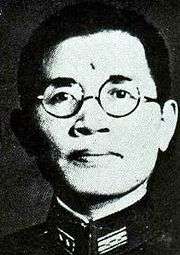Hiromichi Yahara
| Hiromichi Yahara | |
|---|---|
|
Lt. Col. Yahara | |
| Native name | 八原博通 |
| Born |
October 12, 1902 Tottori Prefecture, Japan |
| Died |
May 7, 1981 (aged 78) Unknown |
| Allegiance | Empire of Japan |
| Service/branch |
|
| Years of service | 1923–1945 |
| Rank | Colonel |
| Commands held |
|
| Battles/wars | |
Colonel Hiromichi Yahara (Japanese: 八原博通, October 12, 1902 – May 7, 1981) was the senior staff officer in charge of operations of the 32nd Japanese Army at Okinawa during the American invasion of that island during World War II.
Defense of Okinawa
Yahara, who had taught strategy at the Army War College, was assigned to Okinawa prior to the anticipated American invasion to organize its pre-invasion strategy. His recommended strategy for fighting the American invaders was to continue to tie up the American military as long as possible in a war of attrition (jikyūsen, 持久戦), so that the rumored American invasion of Kyūshū, Japan, would be delayed, thereby allowing Kyushu defenders more time to better prepare their defenses.
Once the Okinawa invasion started, Yahara recommended holding back Japanese forces for as long as possible and using them primarily in a defensive posture, rather than an aggressive one. However, Chief of Staff of the Army, Lieutenant General Isamu Cho, soon became frustrated by the relative inaction of the battlefield, and recommended “banzai” charges at the Americans.
Yahara disagreed with this recommendation, but went along with it. But when it was clear that Cho’s samurai-charge methods were not working, but, rather, causing huge numbers of casualties among the Japanese infantry, along with loss of territory, Cho relented and allowed Yahara to continue to make tactical and operational decisions.
Yahara’s methods, since he did not have the firepower to fight the Americans directly in battle and knew that he could not possibly win, was to fight from caves as long as possible, and then, once the caves were lost, to “retreat and defend” — time after time — until there was no longer any room to retreat to.
Yahara escapes
Lieutenant General Cho and Lieutenant General Mitsuru Ushijima, ordered Yahara to escape from the Mabuni caves after they had committed ritualistic suicide, despite Yahara's pleas to commit seppuku alongside the two generals. This he did, disguised as a Japanese English teacher. This disguise worked well for him on the island, but eventually he was recognized by the U.S. military and made a prisoner-of-war with privileges due his rank.
Literary contribution
After the war Yahara wrote his account of the battle. His Okinawa Kessen (Battle for Okinawa), first published in Japanese in 1973, was an account of his first-hand experience directing Japanese operations on Okinawa during the invasion.
He died in 1981.
Yahara chronology
1902 – Born. Son of a small country landowner in Tottori Prefecture (Japan).
Won appointment to the Military Academy. 1923 – Graduated from Military Academy. Assigned to 54th Infantry Regiment.
1925 – Assigned to 63rd Infantry Regiment.
1926 – Entered Army War College.
1929 – Graduated from War College. Returned to the 63rd Regiment.
1930 – Assigned to Personnel Department of the War Ministry.
1933 – Sent to the United States as an exchange officer. Traveled Wilmington, Delaware, Boston, Massachusetts, Washington, D.C. Attached to the 8th Infantry Regiment for six months at Fort Moultrie.
1935 – Returned to Personnel Department, War Ministry.
1937 – Appointed as instructor (strategy and tactics) at the Army War College. Spent three months in China as staff officer with the 2nd Army (N. China Expeditionary Force).
1938 – Returned to Army War College as instructor.
1940 – September: assigned as Japanese agent to Siam, Burma, Malaya. November–December: reported to General Staff as expert on southeast Asia.
1941 – July: to Bangkok as Assistant Military Attaché. November 15: received secret orders to staff of 15th Army (Saigon). Remained at Bangkok and participated in the negotiations for the peaceful occupation of Siam. Then participated in the Burma operation with the 15th Army.
Became ill and returned to Japan. Again assigned to the War College as instructor.
1944 – 16 March: Assigned to Okinawa as advisor from Imperial Staff. 32nd Army Headquarters soon formed (March 22, 1944) and assigned as Senior Staff Officer.
1945 – July 15: captured by American military at the Yakibu Civilian Compound.
(Source: U.S. Tenth Army Interrogation Report #28, dated 6 August 1945.)
1981 – Died.
Interrogator comments
“Quiet and unassuming, yet possessed of a keen mind and a fine discernment, Colonel Yahara is, from all reports, an eminently capable officer, described by some POWs as the “brains” of the 32d Army.”[1]
See also
Notes
- ↑ U.S. Tenth Army Interrogation Report #28, dated 6 August 1945
References
- Yahara, Hiromichi; Gibney, Frank B. (1995). The Battle for Okinawa. John Wiley & Sons, Inc. ISBN 0-471-18080-7.
- “The Battle for Okinawa” by Colonel Hiromichi Yahara, with introduction and commentary by Frank B. Gibney contains Yahara’s account as well as extensive prisoner-of-war interrogation reports related to the subject.
- Sloan, Bill (2007). The Ultimate Battle, Okinawa 1945, the last epic struggle of World War II. New York: Simon & Schuster. ISBN 978-0-7432-9246-7.
Further reading
For more information on Yahara, see Yahara biographer Takeshi Inagaki's book:
- Higu no Sakusen ... Itan no Sambo Yahara Hiromichi (Shinchosha, 1984)
|
